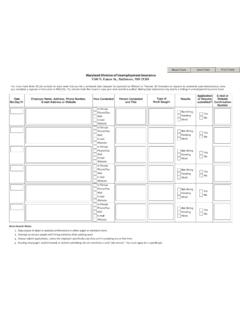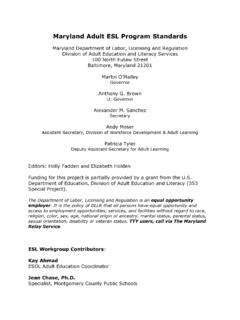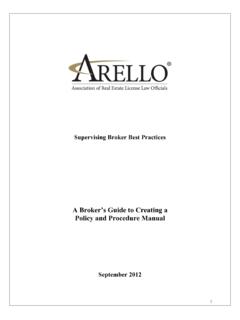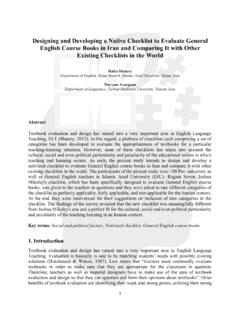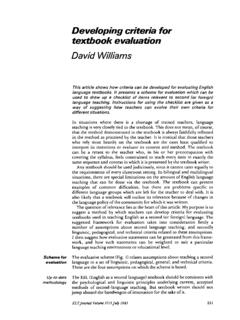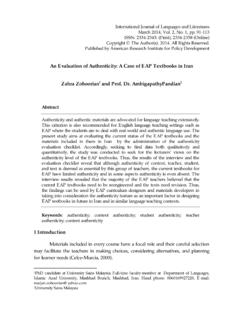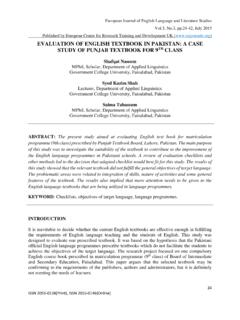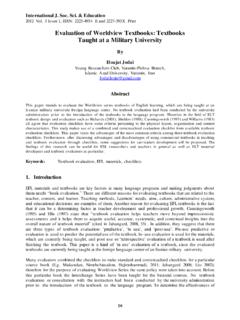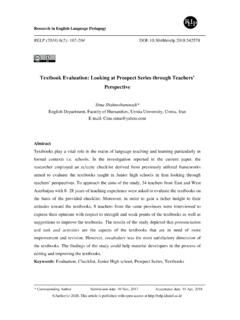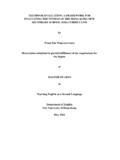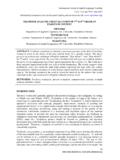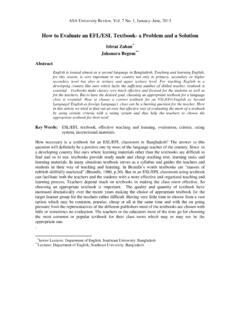Transcription of ESL/ESOL Standards by Skill
1 ESL/ESOL Standards by Skill Listening, Speaking, PronunciationListening, Speaking, PronunciationListening, Speaking, PronunciationReading, Writing, GrammarReading, Writing, GrammarReading, Writing, Grammar9/10/08 Content Standards by Skill 16 Content Standards by skills Learners in an Adult ESL/ESOL class often have different levels of proficiency. Some learners may have stronger oral/aural skills while others may excel in reading/writing. This section, ESL/ESOL Standards by skills , has a sequenced list of skills from Beginning ESL/ESOL Literacy to Advanced ESL/ESOL in each of the Skill areas. If learners in a Beginning level class have stronger literacy skills , the instructor can consult the Reading and Writing skills for the Intermediate level. Conversely, there might be some learners in a High Intermediate or Advanced class who are very proficient verbally, but who may not have had the opportunity to study formally ESL/ESOL . These students may need basic reading, writing and grammar Skill development.
2 The Skill areas included are the following: Listening skills Speaking skills Pronunciation Reading skills Writing skills Grammar 9/10/08 Content Standards by Skill 17 LISTENING skills LEVELS LISTENING skills * Beginning ESL/ESOL Literacy Beginning Literacy ESL/ESOL learners may demonstrate listening comprehension non-verbally Recognize letters of the alphabet Recognize cardinal and ordinal numbers Recognize/respond to basic survival vocabulary, greetings, and polite expressions ( thank you, please, you re welcome) Respond to very simple questions in familiar contexts ( , personal information) Follow simple one-step directions Respond to simple requests for repetition ( nod head, use body language, use the phrase I don t understand) Low Beginning ESL/ESOL Low Beginning ESL/ESOL learners will be able to.. Recognize letters of words when spelled or dictated Recognize/respond to greetings and polite expressions in routine and familiar settings Recognize/respond to simple questions/statements in familiar contexts ( , weather, family, employment) Follow one-step directions in a familiar context to complete a simple task Identify simple expressions indicating lack of understanding Recognize/respond to requests for repetition Recognize/respond to personal information questions High Beginning ESL/ESOL High Beginning ESL/ESOL learners will be able to.
3 Listen for key vocabulary words in contextualized conversations Recognize common words when spelled or dictated Recognize/respond to alternative forms of basic questions in familiar contexts Follow simple multi-step directions and instructions Identify simple expressions indicating lack of understanding Low Intermediate ESL/ESOL Low Intermediate ESL/ESOL learners will be able to.. Respond to statements, questions and commands using some expanded vocabulary Respond to simple social conversation in familiar contexts ( , shopping, employment, school) Follow simple two-step directions and instructions with some detail Identify simple information from a conversation or in familiar contexts ( , listen with a purpose) Use context clues to get main ideas and to identify details Respond to simple requests for clarification Distinguish language use in informal versus simple formal situations ( , pay attention to register) High Intermediate ESL/ESOL High Intermediate ESL/ESOL learners will be able to.
4 Interpret statements, questions and commands in a variety of familiar situations Follow multi-step directions to a specific location Follow multi-step instructions on how to do something Interpret information from a conversation and in a variety of contexts ( , in person, on telephone, over announcement) Identify key information/details in a description Respond to requests for clarification and elaboration Understand more complex structures Distinguish between facts and opinions in conversation Recognize/respond to some common idioms * Respond/Recognize -- especially at the beginning levels, learners may demonstrate listening comprehension non-verbally. For example, extending one s hand and smiling in response to greetings or pointing to a picture/word to demonstrate understanding 9/10/08 Content Standards by Skill 18 LISTENING skills CONTINUED LEVELS LISTENING skills * Advanced ESL/ESOL Advanced ESL/ESOL learners will be able to.
5 Respond to topics beyond immediate survival needs ( , news and events in the workplace or community) Follow detailed multi-step directions and instructions in familiar situations Respond to requests for clarification, elaboration, opinion, etc. Identify details in a description ( , of a person, place or an event) Obtain detailed information in a variety of contexts ( , from conversation or broadcast) Recognize/respond appropriately to social cues in conversation in familiar contexts Recognize/respond to conversational openers/closures and polite expressions as used by native speakers ( , I have to get , I d rather , How about going ) Recognize/respond to idiomatic expressions in familiar situations * Respond/Recognize -- especially at the beginning levels, learners can demonstrate listening comprehension non-verbally. For example, extending one s hand and smiling in response to greetings or pointing to a picture/word to demonstrate understanding 9/10/08 Content Standards by Skill 19 SPEAKING skills LEVELS SPEAKING skills Beginning ESL/ESOL Literacy Beginning Literacy ESL/ESOL learners will be able to.
6 Identify individual letters Use cardinal and ordinal numbers ( , begin to distinguish difference) Greet others Use basic vocabulary for social interaction Ask simple questions in short phrases Produce simple statements Express lack of understanding Respond to simple questions in a familiar situation Ask for repetition ( , What? or Today? ) Low Beginning ESL/ESOL Low Beginning ESL/ESOL learners will be able to demonstrate the following.. Spell some familiar words Use numbers appropriately to provide personal information Produce and respond to common greetings, introductions, and polite expressions Produce simple statements in routine and familiar situations Use the telephone to make an emergency call Respond to simple questions in familiar situations demonstrating some control of grammar High Beginning ESL/ESOL High Beginning ESL/ESOL learners will be able to.. Ask simple questions to satisfy survival needs Spell some sight words Answers simple questions on everyday activities with some detail Participates in short conversations on everyday activities using appropriate conversation skills and monitoring for listener comprehension Give simple one-step instructions and directions Expresses likes and dislikes Express lack of understanding ( speak slower, please rephrase, I don t understand) Use the telephone to make an appointment Low Intermediate ESL/ESOL Low Intermediate ESL/ESOL learners will be able to.
7 Produce simple statements, questions, and commands using familiar vocabulary Participate in routine social conversations in familiar contexts ( , shopping, employment, school) Give simple two-step directions o Retell a simple story Use simple expressions of satisfaction/dissatisfaction and agreement/disagreement Use simple expressions to express opinion Express lack of understanding and ask for repetition or clarification Use appropriate language in both informal and simple formal situations High Intermediate ESL/ESOL High Intermediate ESL/ESOL learners will be able to.. Produce statements, questions, and commands ( , interact) in less familiar contexts with some detail Ask and answer questions using complete sentences when appropriate Give directions to a specific location Provide two and three step instructions with detail on how to do something Request information and express needs ( , in person or by phone) Express satisfaction/dissatisfaction and agreement/disagreement Provide simple descriptions ( , describe a person, place or event) Express opinions and provide factual information 9/10/08 Content Standards by Skill 20 SPEAKING skills CONTINUED LEVELS SPEAKING skills Advanced ESL/ESOL Advanced ESL/ESOL learners will be able to.
8 Participate in discussions on topics beyond immediate survival needs ( , local news) Explain concepts/ideas in organized manner using examples or details Tell anecdotal stories as a part of conversation Give detailed, multi-step directions and instructions in familiar settings Clarify utterances by rewording or repeating in order to be understood by the general public Select and report pertinent information ( , regarding an accident, change in procedure, etc.) Request specific information in person or by phone Use a variety of sentence patterns, new vocabulary, and high-frequency idioms in spontaneous conversation Participate in social interactions using the appropriate degree of formality Negotiate a solution/compromise Use persuasion in conversation 9/10/08 Content Standards by Skill 21 PRONUNCIATION skills Levels PRONUNCIATION skills Beginning ESL/ESOL Literacy The Beginning ESL/ESOL Literacy learner will recognize and practice: Chunks (words that often go together) and linking the words together [It s a ___.]
9 //itza ___//] Letter-sound associations (phonemes) One- and two-syllable word patterns Syllable stress in numbers, days, months, etc. [THIRty verus thirTEEN] Low Beginning ESL/ESOL The Low Beginning ESL/ESOL learner will: Recognize/Reproduce chunks (words that often go together) and linking the words together [It s a ___. = Itza___.] Recognize/Reproduce letter-sound associations (phonemes) Recognize/Reproduce intonation for yes/no questions Recognize/Reproduce Intonation for Wh-questions High Beginning ESL/ESOL The High Beginning ESL/ESOL learner will: Recognize/Reproduce syllable stress of new vocabulary Recognize/Reproduce s-ending sounds: /s/, /z/ and /Iz/ Use intonation for yes/no questions Recognize/Reproduce pronunciation of chunks (words that often go together) and linking the words together Low Intermediate ESL/ESOL The Low Intermediate ESL/ESOL learner will: Contrast/Produce phonemes needed to enhance comprehensibility ( , based on learners needs -- /l/ vs /r/ or /th/ vs /t/) Contrast/Produce stress of multi-syllabic words Contrast/Produce short and long vowel sounds (based on learners needs) Recognize/Reproduce schwa sound used in unstressed syllables Recognize/Reproduce s-ending sounds: /s/, /z/ and /Iz/ Recognize/Reproduce past -ed ending sounds.
10 /t/, /d/ and /Id/ Recognize/Reproduce shift in meaning when using different emphases in sentence stress Contrast/Produce intonation difference for questions and sentences High Intermediate ESL/ESOL The High Intermediate ESL/ESOL learner will: Contrast/Produce phonemes needed to enhance comprehensibility ( , based on learners needs -- /l/ vs. /r/ or /th/ vs. /t/) Contrast/Produce stress of multi-syllabic words Contrast/Produce short and long vowel sounds (based on learners needs) Recognize/Reproduce schwa sound used in unstressed syllables Recognize shift in meanings when using different emphases in sentence stress Articulating word endings Produce intonation differences for questions and sentences Phrase words into thought groups or chunks and pause between the phrases Advanced ESL/ESOL The Advanced ESL/ESOL learner will: Produce stress of multi-syllabic words, using learned rules to guess stress of new words Phrase words into thought groups and pause between the phrases Demonstrate conversation management techniques, such as interrupting and turn-taking 9/10/08 Content Standards by Skill 22 READING skills LEVELS READING skills Beginning ESL/ESOL Literacy Beginning Literacy ESL/ESOL learners will be able to.


